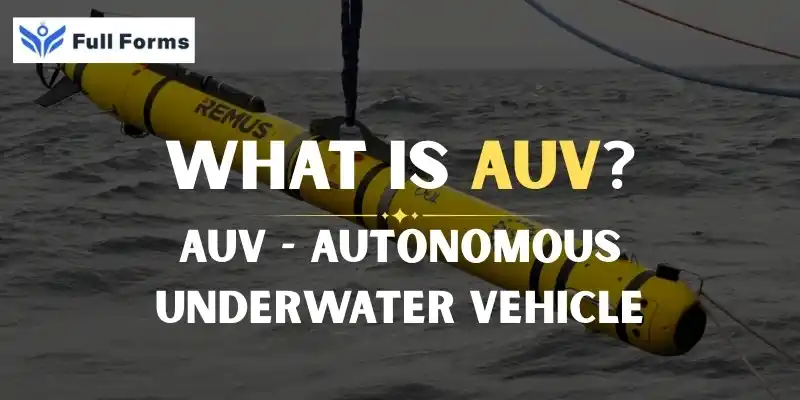Autonomous Underwater Vehicle
(AUV)

Description
AUV stands for Autonomous Underwater Vehicle, which means it can go deep without a person on board.
People have found great ways to explore even the most remote places on Earth, like the ocean's depths. Because technology is changing so quickly, this kind of exploration is possible. One of these amazing pieces of technology is the Autonomous Underwater Vehicle, or AUV for short.
What kind of vehicle can move through water by itself?
An Autonomous Underwater Vehicle (AUV) is a robot that can move through water by itself. It works on its own, as the name suggests. This means that once it is put in the water, it will follow a set path or mission without needing to be told what to do all the time.
AUVs don't need cables or radio signals to get around like remote-controlled submarines do. They have cameras, sonar, sensors, and even AI systems that help them move around and collect data.
What does an AUV do?
AUVs are like flying drones that go through water. Before a mission starts, scientists or engineers tell the AUV what to do, such as
- Where to go
- How deep to go down
- What information to collect?
- When to return
The AUV follows its path after being thrown into the ocean by using a mix of navigation tools, such as GPS, inertial navigation systems, and sonar. AUVs use dead reckoning and acoustic signals to find their way because GPS doesn't work underwater.
Some advanced AUVs can make decisions right away, like changing their course when they see something interesting or an obstacle.
What does an AUV look like?
AUVs come in a wide range of sizes and shapes. Some look like small torpedoes, while others look like fish or gliders. An AUV usually has:
- The AUV has a body that is streamlined, allowing it to move easily through water.
- Fins or propellers will help you move forward.
- Rechargeable batteries, typically lithium-based, power them.
- The sensors can measure temperature, pressure, and salinity.
- We use sonar and cameras to find things or make maps of the ocean floor.
What makes AUVs so important?
The ocean covers more than 70% of the Earth's surface, yet our understanding of it remains limited. AUVs can help us see parts of the ocean that are too deep, dark, or dangerous for people to go to.
We use AUVs for these important jobs:
1. Looking in the ocean
AUVs help map the ocean floor, find hydrothermal vents, and study marine life in places that divers and submarines can't reach.
2. They keep an eye on the environment all the time.
They keep an eye on oil spills, pollution levels, and how climate change affects other aquatic ecosystems.
3. The military and the defence sector utilise AUVs.
Navies use AUVs to locate mines, inspect submarine cables, and monitor the water.
4. Archaeological research
AUVs help people find and study shipwrecks and other historical sites that are underwater with little risk to them.
5. The Oil and Gas Business
AUVs check pipelines, underwater equipment, and seabeds to make sure oil and gas companies can do their jobs safely.
6. Science research
Marine scientists need AUVs because they can study ocean currents, measure salinity, and collect biological samples.
AUVs are advantageous because they operate without onboard personnel, eliminating the risk to human safety, even in adverse weather conditions.
- Cost-effective: You need fewer tools and people.
- Autonomous: You don't have to talk to or control all the time.
- AUVs gather high-quality data with cutting-edge sensors and tools.
- Longer Reach: Can go deeper and farther than other underwater vehicles.
Issues with using AUVs
AUVs have some good things about them, but they also have some technical and environmental issues:
- Problems with navigation: It's difficult to get around underwater without a GPS.
- Battery Life: If the power level is low, the mission might not last as long.
- Communication: Sending data through water is slow and not very reliable.
- High Cost: It can be expensive to build and maintain advanced AUVs.
But these problems are getting easier to fix as technology gets better.
What Will Happen to AUVs in the Future
AUVs have a bright future ahead of them. With advancements in AI and improved communication methods for AUVs underwater, these vehicles may be able to do the following in the future:
- Collaborate in groups (swarm robotics).
- Do your own research in science.
- Fix things that are underwater.
- You can stay underwater for weeks or even months without needing to come up for air.
Because oceans are still one of the last great frontiers, AUVs will keep taking us to new places and teaching us more about our planet than ever before.
In short
The Autonomous Underwater Vehicle is a wonderful example of how far robotics has come. It is a machine that goes deep, works quietly, and gets useful information from places that are hard for people to get to. AUVs are important for the military, business, and science. They can find things that are dangerous under the water and make maps of the ocean floor.
AUVs are robots that go out into the ocean to look around. They let us see and hear what's going on in the deep blue world below the waves.
